Addressing attitudes to gender equality
from millennial men
The state of play
According to current conversations millennials, more so than previous generations, are attracted to employers with corporate social responsibility values that align to their own and avocado on toast. Both of which seem reasonable and delicious to us.
Young Men Averse to Gender Equality
Research from the University of Canberra’s 50/50 by 2030 Foundation has shown that young men, in particular, are actually averse to gender equality, and this has important implications for workplace and culture. The study explored the generational attitudes of men and women to issues of gender equality.
The resulting report, From Girls to Men, disrupts the assumption that that men’s views towards gender equality have been getting more progressive over time.
The results reveal that, despite having a high level of ‘knowledge and understanding about the nature of gender inequality’ in Australia, a growing number of men, feel ‘alienated from the process of change and are backsliding into traditional value systems’ 2.
Globally this is reflected in some young men who have found solace among masculinised narratives, anti-feminism and the racial politics of the alt-right 3.
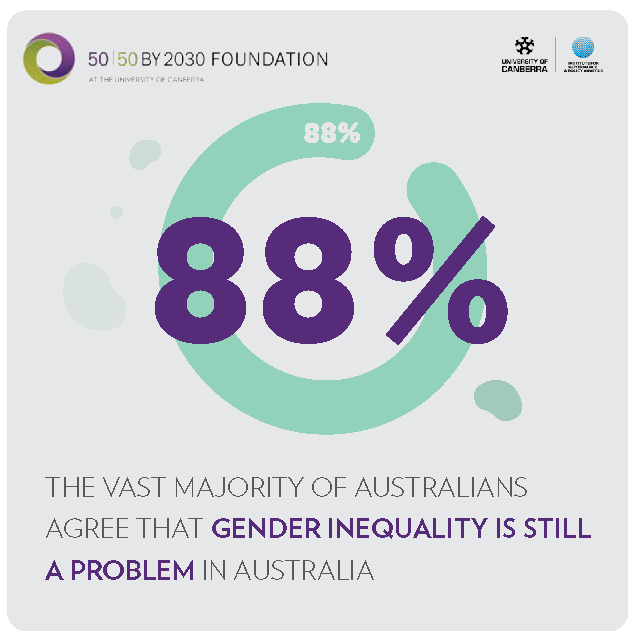
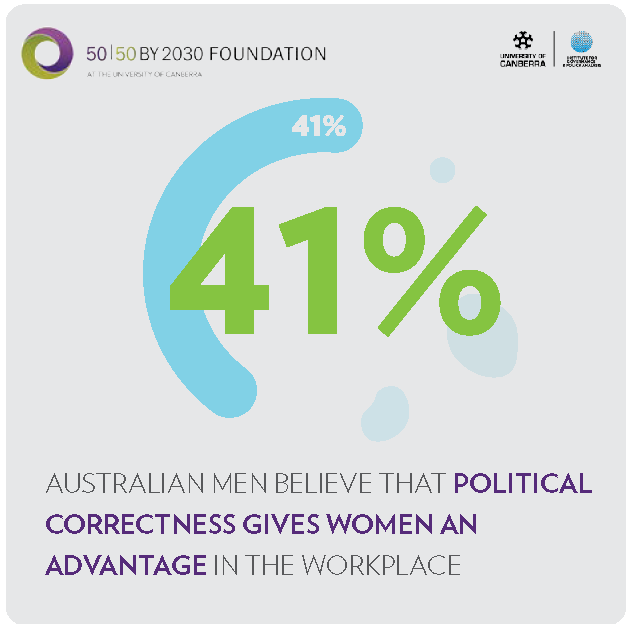
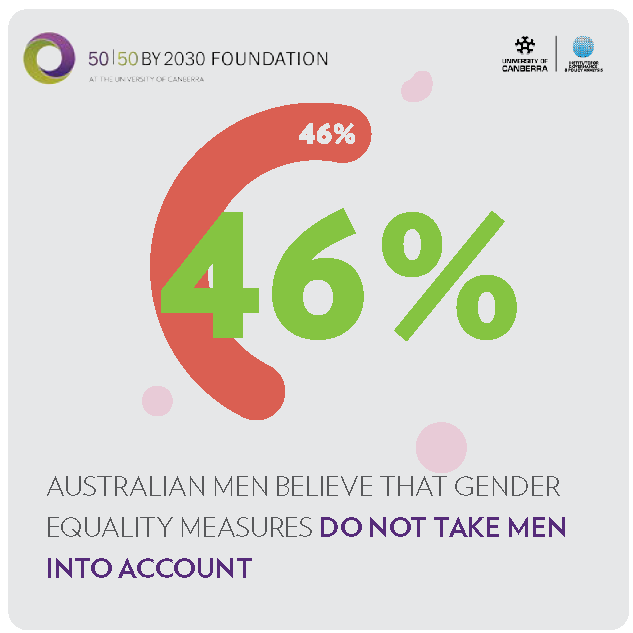
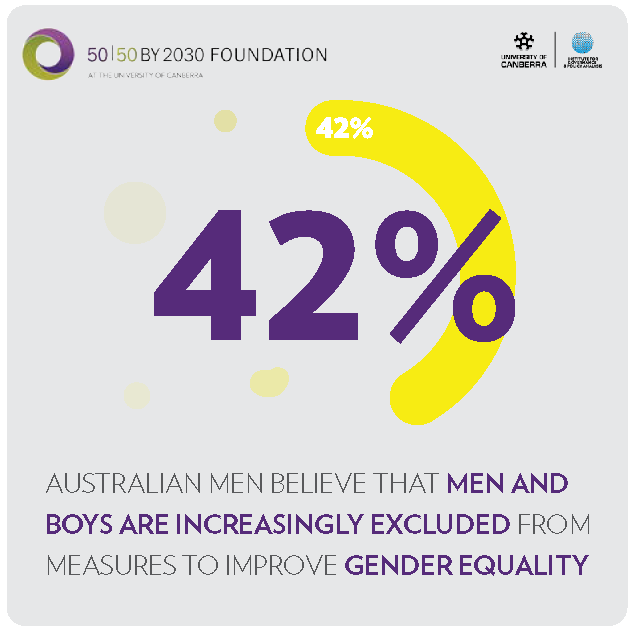 4.
4.
Exclusion and Fear of Change Halting Progress
The results shown above, reveal that more so than other generations, millennial men view themselves as outsiders and feel excluded from one of the key areas workplaces are addressing: gender equality.
This shift is as complex as it sounds. While there has been a decline in traditional views towards women, there is a large group of young men who moderately support gender equality but also have a ‘fear of change and increased economic insecurity’.
However, it should be iterated that millennials are an extremely diverse group in terms of social income, cultural background, religion, and educational background. Our generational category ranges across a broad age group (24 to 38 years) who may be at very different stages in their life.
Organisations should always be cautious in implementing workplace strategies that target unique characteristics of generations, as stereotyping in the workplace can create more harm than good. 5
We know from DCA’s Inclusion@Work that inclusion is good for business. If you work in an inclusive team, you are ten times more likely to be highly effective than workers in a non-inclusive team, nine times more likely to innovate and 5 times more likely to provide excellent customer / client service. It is not only relevant within a broader social context, but also as a business imperative for teams to be inclusive across the board.
For Diversity and Inclusion (D&I) practitioners, the key questions become: how well are we including young men in our D&I initiatives? And how can we use evidence to engage young men in gender equality initiatives?
More information and recommended strategies in the members’ section below.
- 1. Lucia Peters, ‘The Best “Disloyal Man” Meme Tweets Just Made Cheating On Bae Cool Again’ (August 25 2017) Bustle.
- 2. M Evans, V Haussegger AM, M Halupka, P Rowe, ‘From Girls to Men: social attitudes to gender equality in Australia’, 50/50 by 2030 Foundation (2018)
- 3. Angela Nagle, ‘The Lost Boys: The young men of the alt-right could define American politics for a generation’ (December 2017) The Atlantic; Derek Thompson, ‘What are young non-working men doing’ (25 July 2016).
- 4. M Evans, V Haussegger AM, M Halupka, P Rowe, ‘From Girls to Men: social attitudes to gender equality in Australia’, 50/50 by 2030 Foundation (2018) p.11
- 5. Philip Taylor, Warwick Smith, ‘What’s Age Got to Do With It? Towards a New Advocacy on Ageing and Work’, percapita, (2017).
Addressing attitudes to gender equality from millennial men continued
Tip #1: Tackle zero-sum thinking
When rolling out D&I initiatives that focus on a particular group, such as women’s leadership development programs, D&I practitioners may hear concerns that women are experiencing preferential or ‘special’ treatment in the workplace at the expense of men. This can often arise from Zero-sum thinking, in which people assume that resources invested in one employee segment only benefit that group; basically, it’s a ‘winners/losers’ narrative.
However, DCA’s Inclusion@Work research revealed that Australian men benefitted just as much as women from their organisation taking action to create a more diverse and inclusive workplace. 1
How? Inclusion initiatives actually boost male employees’ job satisfaction success and security as much as, and sometimes more than, female employees.
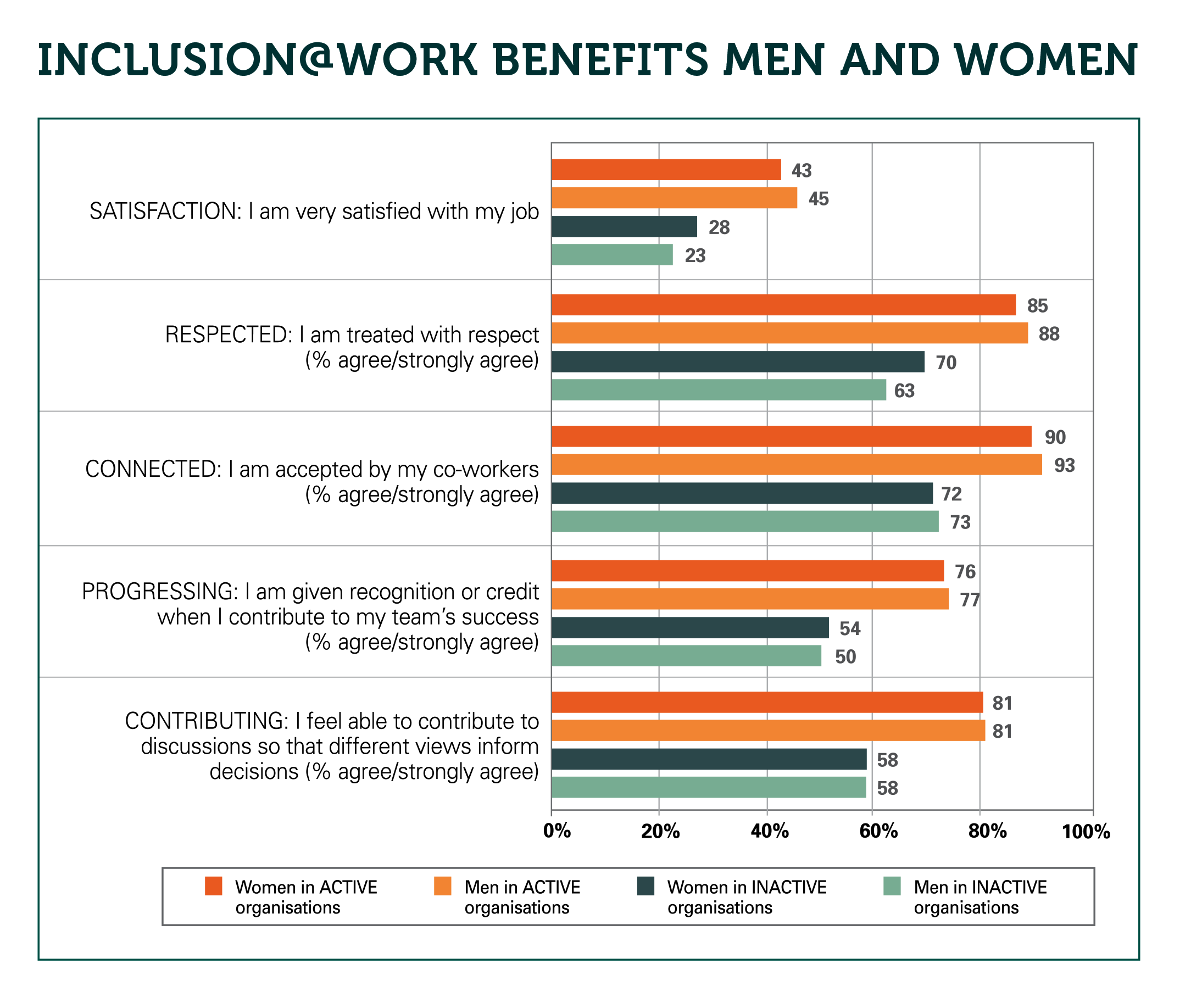
Source: DCA-Suncorp Inclusion@Work Index 2017 – 2018: Mapping the State of Inclusion in the Australian Workforce (2017).
Tip #2: Address economic insecurity
A key concern for young men is economic insecurity. KPMG’s Meet the Millennials report found that 40% of millennials think their jobs will be outsourced or replaced by automation within the next 5 years. Security was highlighted in this study as a top five priority for both employed and job seeking millennials.2
Australian research has also shown that the Global Financial Crisis has hit young men particularly hard – and that they’re yet to recover with a lasting decline in employment and full-time work compared to older workers. 3
Today unemployment and underemployment rates,4 a widening wage growth gap between early career starters and mature workforce,5 increasing tertiary education debt and job insecurity, the pressures of home ownership6 are all factors to consider in the desire all young workers have for security.
So it’s important to recognise the role economic insecurity may play in the backlash against gender equality and to separate the two issues. Although the current economic climate has created greater symmetry between young men and women in time spent in paid work and on housework and caring duties, economic insecurity has not been driven by women’s higher education attainment, economic gains and increased workforce participation. 7
In reality, we know that women remain at a greater risk of poverty, financial insecurity and insufficient pension savings.8
For organisations, ensuring men have equal access to parental leave and developing gender-neutral parental leave policies is fundamental to encouraging shared caring responsibilities and increasing workforce participation of women.
Tip # 3: Challenge ‘traditional masculinity’
A recent study has shown that young men who conform to traditional definitions of manhood are more likely to have poor mental health, have suicidal thoughts, take risks at work, drink excessively and drive dangerously, 9 they are also less likely to access preventative healthcare and partake in self-care.10
‘Traditional’ manhood being: rigidity of gender roles, heterosexuality and homophobia, toughness, self-sufficiency, aggression, hyper-sexuality and control over women. It’s what the men’s project call the ‘Man Box’. This study found that men who agree more strongly with these ideals are more likely to sexually harass women, bully other people (physically, verbally and online) and are far less likely to intervene when other men are acting violently.11
Dr Michael Flood12 argues that to combat this
“We need to engage men and boys in critical conversations about manhood, encouraging them to embrace identities of their own making rather than conforming to constrained masculine scripts. We should also highlight how young men are changing and adopting diverse viewpoints on what it means to be a man”
And this is important more than ever. Suicide is one of the leading causes of death in Australian men, and the Black Dog Institute has identified, ‘unhelpful conceptions of masculinity’ as one of the consistent risk factors in male suicide, which contribute to 80% of all suicides in Australia.13
It is crucial that leaders are engaged in the concerns and challenges faced by their young workers, we know that no business strategy can deliver real results if individuals in positions of power are disconnected from that strategy.14 This large group of men in the workforce and will only grow, and their attitudes will inevitably impact those around them.
DCA’s Engaging Men research shows that with progress towards gender equality in workplaces, men will enjoy workplaces with greater productivity, creativity, and diversity because of the wider pools of talent and fairer processes on which they are based. Men will also experience higher quality work resulting from greater teamwork and collaboration and equal opportunities. Finally, men will benefit psychologically from being active participants in the process of positive change.15
Tip # 4: Get flexible
DCA’s Men Get Flexible research findings suggest that a significant number of men desire greater access to flexible work in various formats, especially in the case for young fathers.16 Flexibility is a key desire for millennial men reflected in the 2018 Deloitte Millennial Survey and KPMG’s Meet the Millennials report.
When men have greater access to flexible work it results in lowered work and life conflict. They are more effective in their jobs, report increased work performance and have lower levels of personal stress and burnout. However, men are actually twice as likely as women to have requests for flexible work hours rejected.17
Consider how flexibility is designed in your organisation from a team or organisational level. Use DCA’s Future-Flex guidelines to allow employees to access flexibility across all roles, for any reason, and can have successful engaged careers.
So how do we engage young men in the workplace?
How men think, behave, and how they relate to women and other men, all play an important part in keeping gender inequalities alive. Men’s attitudes and behaviours can support or challenge the status quo. Men have a vital role to play in building a world of gender equality – and many are already doing so.18
Based on, DCA research, here are the most effective ways to engage men – especially young men – on gender equality at work:
- Get the foundation right – ensure gender equality initiatives involve women and men as active and equal partners.
- Get the framing right – treat gender equality as a business issue, not a women’s issue.
- Go wide – make visible and target all key gender equality areas (i.e. paid work, power and decision-making, financial security, personal safety, interpersonal work relationships, caring, and community involvement).
- Get the messaging right – to appeal to men as well as women.
- Engage a diversity of men – including men in different organisational roles and levels, and with a variety of demographic backgrounds (e.g. ages, cultural backgrounds, sexual orientations).
- Educate about how to lead change effectively – by resourcing initiatives, being visible and persistent, and ‘walking the talk’.
- Make the connection between work and home – by implementing initiatives that encourage gender equality in caregiving.
- Make the connection between work and communities – by framing gender inequality as a societal/community problem.
- Build individuals’ gender confidence and capability – by providing opportunities for both men and women to change their mindsets, assumptions, and behaviours.
- Encourage men and women to challenge and change gender-biased organisational policies and practices.
For useful resources on engaging men, please see
- DCA’s Men Make a Difference: Engaging Men on Gender Equality research
- DCA’s Men Get Flexible! & Future-Flex: Mainstreaming Flexibility by Design research
- VicHealth’s Encountering Resistance: strategies to respond to resistance to gender equality initiatives
- Male Champions of Change and Chief Executive Women’s Backlash & Buy-In: responding to the challenges in achieving gender equality
- 1. Diversity Council Australia (O’Leary, J. and Legg, A.) DCA-Suncorp Inclusion@Work Index 2017 – 2018: Mapping the State of Inclusion in the Australian Workforce (2017) p14.
- 2. S Kurian et al. ‘Meet the Millennials’, KPMG UK, p.12
- 3. Matt Wade, ‘Financial crisis hit young men hard – and they’re yet to recover’ (4 November 2018), The Sydney Morning Herald.
- 4. Youth unemployment (15-24) is currently sitting at 13.3%, double the broader population, and under-employment is at 20% even though 76% of youth say they want to be working on a full-time basis, (Carrington Clarke, ‘Millennial survey shows youth feeling aggrieved, frustrated by the way country is being run’, (8 February 2017) ABC News.
- 5. Youth unemployment (15-24) is currently sitting at 13.3%, double the broader population, and under-employment is at 20% even though 76% of youth say they want to be working on a full-time basis, (Carrington Clarke, ‘Millennial survey shows youth feeling aggrieved, frustrated by the way country is being run’, (8 February 2017) ABC News.
- 6. Joseph Stiglitz, ‘Young people are right to be angry about their financial insecurity’ (17 March 2016), The Guardian.
- 7. Matt Wade, ‘Financial crisis hit young men hard – and they’re yet to recover’ (4 November 2018), The Sydney Morning Herald.
- 8. Felicity Hannah, ‘Female? Here’s why you’ll be on the financial back foot forever’ (30 November 2016), Independent.
- 9. Michael Flood, ‘Australian study reveals the dangers of ‘toxic masculinity’ to men and those around them’ (October 16 2018), The Conversation, https://theconversation.com/australian-study-reveals-the-dangers-of-toxic-masculinity-to-men-and-those-around-them-104694?utm_medium=email&utm_campaign=Latest%20from%20The%20Conversation%20for%20October%2017%202018%20-%201138010251&utm_content=Latest%20from%20The%20Conversation%20for%20October%2017%202018%20-%201138010251+CID_e334afbf5257347ab2e6141fc26637a2&utm_source=campaign_monitor&utm_term=Australian%20study%20reveals%20the%20dangers%20of%20toxic%20masculinity%20to%20men%20and%20those%20around%20them.
- 10. Stephanie Pappas, ‘Continuing Education: APA issues first-ever guidelines for practice with men and boys’ (January 2019), Monitor in Psychology. pp. 36.
- 11. The Men’s Project & Flood, M, The Man Box: A Study on Being a Young Man in Australia. (2018) Jesuit Social Services.
- 12. Michael Flood, ‘Australian study reveals the dangers of ‘toxic masculinity’ to men and those around them’ (October 16 2018), The Conversation.
- 13. Alex Bruce-Smith, ‘A study has now identified the leading causes of suicide in men’ (25 June 2015) Pedestrian TV.
- 14. Diversity Best Practices, ‘Engaging White Men As D&I Champions and Allies’ (2017). Millennials are on the rise. In five years’ time, they will make up half of the Australian workforce, which will increase to 75% in 2025.Kronos White Paper: ‘Motivating Millennials: Managing tomorrow’s workforce (2016).
- 15. Diversity Council Australia (M. Flood and G. Russell), Men Make a Difference: How to Engage Men on Gender Equality (2017). p.14
- 16. Diversity Council Australia (Russel, G. and O’Leary, J.) Men get flexible! Mainstreaming Flexible Work in Australian Business. Creating quality flexible work and careers as standard business practice in Australian workplaces, (2012) p8.
- 17. Diversity Council Australia, Myth Busting Flexibility: Using evidence to debunk common myths and assumptions, Sydney, Diversity Council Australia, 2018, p 8.
- 18. Diversity Council Australia (M. Flood and G. Russell), Men Make a Difference: How to Engage Men on Gender Equality (2017). p.4

